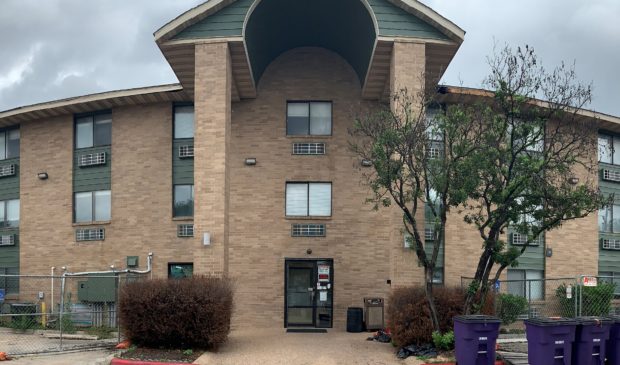Newsletter Signup
The Austin Monitor thanks its sponsors. Become one.
Most Popular Stories
- Firefighters to seek firing of Chief Baker
- Office slowdown sparks new downtown housing ambitions
- Downtown Historic Resource Survey eyes seven new districts eligible for designation
- With cap of $687M, bond task force to weigh $4.4B in city needs
- Elon Musk narrowly wins fight against neighbors over Austin-area home
-
Discover News By District
Popular Whispers
Sorry. No data so far.

Photo by city of Austin
City’s HEAL team moves four encampments to bridge shelters
Monday, September 13, 2021 by Kali Bramble
In the wake of the reinstated camping ban this past May, stakes have risen considerably for those at the helm of the effort to rehouse Austin’s homeless population. Nonetheless, Project HEAL – the Homeless Encampment Assistance Link – which City Council adopted back in February, has moved full speed ahead with its plans to rehouse those seeking shelter at four of the city’s largest camps.
Homeless Strategy Officer Dianna Grey briefed the Public Health Committee last week with news that her team had completed phase one of the HEAL initiative as of Aug. 31. According to Grey, the project had provided 143 people with temporary housing and aimed to permanently house over 300 by the end of its second phase.
This accomplishment, which Grey described as the result of a “Herculean effort” by a team of Homeless Strategy Office workers and social services contractors, began with the rapid transformation of a hotel in South Austin that previously served as an emergency Covid shelter. Now dubbed Southbridge and equipped to provide services to aid in the transition from temporary to permanent housing, the shelter welcomed roughly 20 people from the encampment at Terrazas Branch Library in mid-June, followed by around 50 from the camp at Ben White and Manchaca in mid-July.
With Southbridge at capacity, the Homeless Strategy Department opened up a Northbridge shelter site in another hotel near 183 and Interstate 35 in early August. The street team worked quickly to relocate two more encampments located at the downtown corner of Cesar Chavez Street and Congress Avenue and the northern intersection of U.S. Highway 183 and Oak Knoll Drive to the new site.
Data collected from the four sites played a central role in the committee’s evaluation of the pilot program. Grey emphasized the fact that 95 percent of people voluntarily accepted a spot in the program as evidence of success: “The banner here is near universal acceptance of relocation.”
Another metric of interest was the program’s attrition rate. “Analyzing the attrition rate will be critical, because it will tell us what we need to add or think about for that stage of going from temporary shelter to permanent housing,” said Council Member Ann Kitchen, who is responsible for introducing the project back in February. Of the 147 people who entered the temporary shelters, 122 (83 percent) remain on the path toward permanent housing or have transitioned into permanent homes.
As of now, only three people have completed the full transition into permanent housing. Despite this modest figure, Mayor Steve Adler framed the completion of Phase I as the first steps toward an ambitious goal of “housing 3,000 people in three years,” which was established at Austin’s Summit to Address Unsheltered Homelessness this past spring.
The rehousing effort led by the HEAL initiative has been criticized by voices on both ends of the political spectrum.
Political action committee Save Austin Now filed a lawsuit in August accusing the city of failing to enforce the camping ban as outlined in Proposition B. While the Homeless Strategy Office says it remains committed to its pre-ban approach of “voluntary compliance strategies,” the Austin Police Department has begun issuing citations as it enters the final stage of implementing the proposition.
Meanwhile, those opposed to the ban have argued that HEAL’s “cleanup efforts” could legitimize the campsite sweeps that have been criticized for their inhumane treatment of campers and seizure of property. Addressing these concerns, Grey noted that her team was careful to ensure the safe relocation of important items such as identifying documents and medicine, but conceded it was not feasible to store all of the items found at the encampments.
The next challenge for the Homeless Strategy Office will be determining the campsites designated for phase two, which it will prepare for discussion at the Public Health Committee’s next meeting on Oct. 6.
Photo caption: Once a hotel in South Austin, Southbridge now provides shelter and support services for people experiencing homelessness through the city’s HEAL initiative.
The Austin Monitor’s work is made possible by donations from the community. Though our reporting covers donors from time to time, we are careful to keep business and editorial efforts separate while maintaining transparency. A complete list of donors is available here, and our code of ethics is explained here.
You're a community leader
And we’re honored you look to us for serious, in-depth news. You know a strong community needs local and dedicated watchdog reporting. We’re here for you and that won’t change. Now will you take the powerful next step and support our nonprofit news organization?


